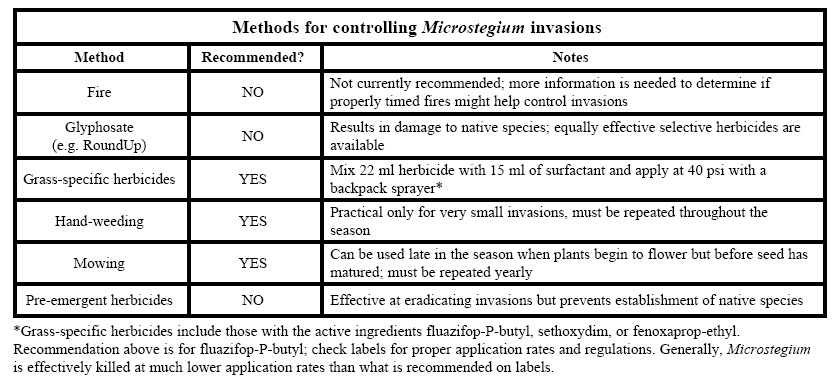Summer 2010
Volume 19 No. 2
Management of Microstegium vimineum (Japanese stiltgrass)
by S. Luke Flory
Introduction
Microstegium vimineum (Japanese stiltgrass) is a nonnative annual grass that was introduced to the southeastern U.S. from Asia in the early 1900s. Following a lag period of more than 60 years, it became highly invasive and is now found throughout the eastern U.S. Microstegium is listed as an invasive species in more than 20 states from New York to Florida, from the eastern seaboard to Missouri. It is often found invading along roads, trails, and streams but can colonize a variety of habitats including sunny, open ridge tops and bottomland riparian habitats.
Areas that have recently been naturally or anthropogenically disturbed (e.g. windthrows or timber harvests) are especially vulnerable to invasions. Microstegium produces abundant seed, spreads quickly, and can require years of management to eradicate. Natural areas managers should be diligent in locating and eradicating new populations.
Species biology and identification
Researchers believe that Microstegium may be filling an empty niche in eastern deciduous forests where most native grasses are C3 species (i.e. cool season grasses). Microstegium employs the C4 photosynthetic mechanism (i.e. it is a warm-season grass) but is very unusual because it is also highly shade tolerant. Microstegium germinates in late spring but is relatively small (< 20 cm tall) until mid to late June. It is most productive during the warm summer months when native species are less active and can grow to more than 2 m in height, although it often falls prostrate and roots at nodes along the stem.
Microstegium can be identified by its relatively broad, bright green leaves that often form a shallow ‘v’ as they extend from the stem (see photo below). Leaves also have a faint silver line down the mid-section. Microstegium can be confused with native Leersia spp., Dicanthelium clandestinum, and other species, but is distinguished by its growth form: it is most often found in dense patches > 1 m in diameter. Microstegium produces seed in September and October and then senesces to create a dense layer of thatch that may inhibit native species including tree regeneration.
Effects on native species and ecosystems
Invasions of Microstegium can quickly crowd out native species resulting in significant reductions in herbaceous species abundance and diversity. Invasions can also reduce tree regeneration, but there appear to be differential effects among tree species, suggesting that invasions may alter forest composition. Microstegium may impact native species through multiple mechanisms including competitive exclusion, changing soil properties, reducing light availability, and increasing native consumer activity. Recent evidence shows that the abundance and diversity of arthropods is reduced in invaded areas. In addition, nitrogen and carbon cycling processes can be altered by invasions.
Senesced Microstegium is slow to decompose, resulting in a dense mat that can inhibit native species recruitment. Fortunately, removing Microstegium with grass-specific herbicides or hand-weeding, significantly increases native species biomass and diversity and tree regeneration.
Management solutions
Microstegium often invades very large areas (i.e. acres), so although multiple methods may be used to kill Microstegium, there are few practical techniques. Suggested methods include hand-weeding, mowing, and non-selective and selective herbicides. Recent research has shown that invasions can be successfully removed with hand-weeding, mowing, or selective herbicides but that the recovery of the native community and return of invasions the following season vary greatly among removal methods. Hand-weeding is effective for small invasions and mowing helps to reduce seed production in flat, easily accessible areas such as along roadsides if conducted as plants begin to flower. For large invasions in areas with trees or steep topography, selective herbicides are preferred. Grass-specific herbicides can economically eradicate large invasions, prevent re-invasion the following year, and allow native species to recover. Fluazifop-Pbutyl (12 oz/ac; Fusilade DX; Syngenta Crop Protection, Inc., Greensboro, NC) mixed with a nonionic adjuvant surfactant and applied with a backpack sprayer for example kills more than 99% of standing Microstegium and prevents recolonization of sites the following year. Removal of Microstegium with this method results in increased native species productivity and diversity, including more than 120% increase in native tree regeneration. Other grass-specific post-emergent herbicides have been shown to have similar effects.

Various online and in-print documents have recommended mowing, fire, pre-emergent herbicides, and non-selective herbicides such as glyphosate. However, these methods may either increase the rate of Microstegium spread (e.g. mowing spreads seeds) or inhibit native species recruitment or recovery (e.g. glyphosate and pre-emergent herbicides kill all species) and are therefore much less preferred over grass-specific herbicides for controlling Microstegium invasions.
